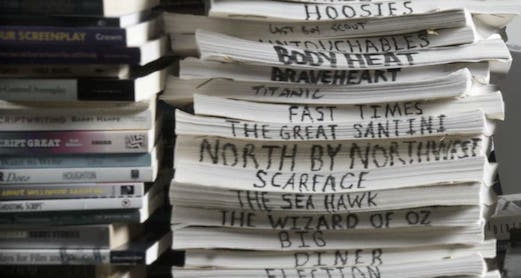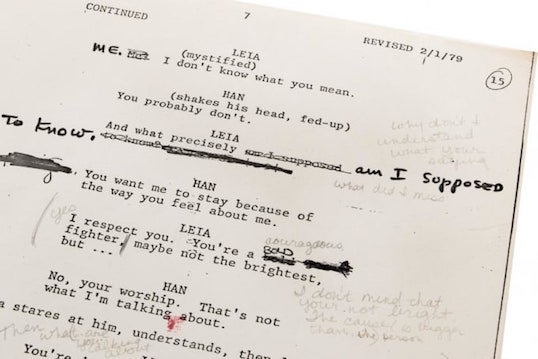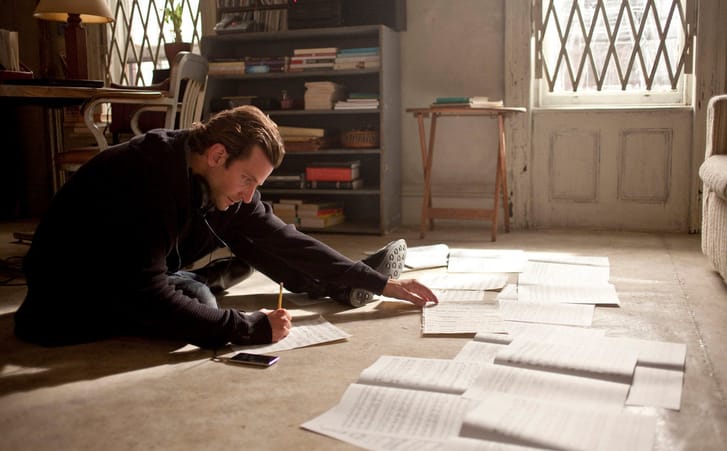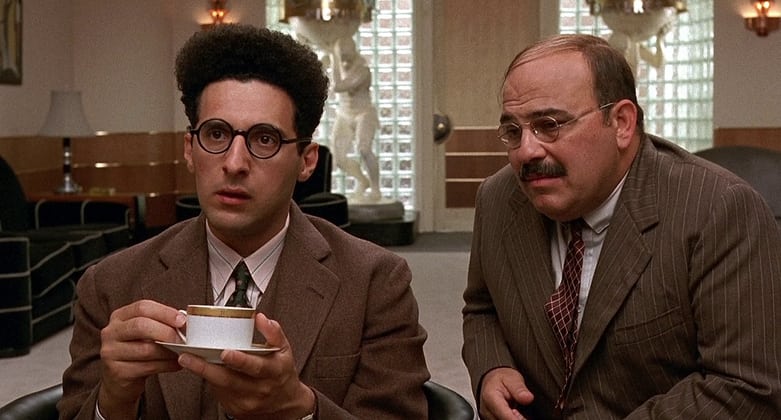There’s often a misconception around the meaning of the term ‘greenlit’. There is a vast difference between a producer/studio commissioning a script and a movie getting greenlit. Usually, it goes in that order.
It’s important to demystify the process of a movie getting greenlit, especially for those starting their career in screenwriting who might dream of it being as simple as: write script, get paid, repeat.
Unfortunately, the process from script to screen is longer, more complex and can sometimes result in collapsed projects.
And no matter how hard a screenwriter labours over a script or how big of a star signs on for a movie, you still need that green light to enter production.
Therefore, it’s important for screenwriters to understand what the journey could look like, from idea, through development, to pitching and finally getting that enviable green light.
Table of Contents
- What Does ‘Greenlit’ Mean?
- 1. No One (Pretty Much) Gets Their First Screenplay Greenlit
- 2. Ideas are Everywhere
- 3. Outside Input is Key
- 4. Script Development
- 5. Writing and Rewriting
- 6. Getting Your Screenplay Greenlit
- 7. Contracts
- 8. Ease the Greenlit Process by Being Open to Notes
- 9. The Many Paths a Greenlit Project Can Follow
- In Conclusion
- In Summary
What Does ‘Greenlit’ Mean?
Greenlit is a term used in the film and TV industries when the “powers that be” approve and authorize a production.
- If a pitch succeeds, a film receives a “green light”, meaning someone offers financial backing.
- This is typically a major film studio, film council, or independent investor.
- The parties involved negotiate a deal and sign contracts.
Once all parties have met and the deal has been set, the film may move into the pre-production and principal photography period. By this stage, the film should have a clearly defined marketing strategy and target audience.

By common industry practices, in order to be greenlit, a project should meet most of the following criteria:
- Mutually approved script.
- Lead actors attached (at minimum a letter of intent from actor or rep).
- Mutually approved budget.
- Director attached (at minimum a letter of intent from director or rep).
- Mutually approved production schedule.
- Fully executed agreement with a funding source(s) (outlining the amount to be invested, and a cash flow that is in accordance with the talent and crew payments).
- Proof of funds in the bank, or at least fully accounted for.
The package above is the key to getting a project greenlit in the studio system. As you can see, multiple factors lead up to a greenlit film.
Sometimes outlines and pitches are greenlit. This is usually true with franchise movies (or star-driven vanity projects). Often those pitches or packages render the actual script somewhat irrelevant.
For instance, Speed was greenlit on the basis of a strong pitch concluding “it’s basically Die Hard on a bus”, while Aliens was greenlit on the basis of James Cameron writing “Alien$” on a whiteboard.
1. No One (Pretty Much) Gets Their First Screenplay Greenlit
Screenwriters very rarely sell their first screenplay. That’s just the hard truth. It might take a handful of screenplays before a writer gets one greenlit. It can happen, but it’s the exception rather than the norm.
Your first script is where you make mistakes. Heck, even your second and third scripts are for ironing out the kinks. The fourth script is where you really understand the structure and craft whilst your fifth script is where you start finding your voice.

Using your first handful of scripts as an exercise to learn how to write screenplays is necessary to get the practice hours in, discover your style and work out your process.
“Writing is like playing the violin, you get better with practice… The more you do it, the better you’re gonna get, and the more you do it, the more comfortable you’re going to become with your own voice and your own style, and those are the things that you can only learn on your own.”
– Aaron Sorkin
Get your craft to the point that it’s so good that people can’t deny it. Make people have faith in your work, even if you’re yet to get that green light yet. It’s perfectly normal to be a working, admired screenwriter without a greenlit project.
And remember, it’s not about doing one script and hoping it sells. You’re most likely going to be writing a lot of scripts before you get one that’s good enough to be considered for a pitch. So a love of the writing process is very important.
2. Ideas are Everywhere
No matter where you are on a project it’s important to take in inspiration from around you for your next potential screenplay.
Whether you obsessively collect any and all ideas or sources of inspiration from images, articles or Youtube videos, or you jot down a sentence in your notebook.
Having a list of ideas to work from will differentiate you from the fly-by-night dreamers hoping to sell their first and only screenplay. Screenwriting is a craft. It is a life-long investment.

The ideas you are left with will be stories worth writing and adding to your arsenal of scripts. This will serve you well as most people who sell or option their script have at least 2-3 ready to go feature-length scripts or TV spec script ideas.
Having completely ready to present scripts to the market place is a minimum of what is needed to be taken seriously by decision-makers.
But at the same time, it’s important not to write just to get greenlit.
If you’re thinking about the sale whilst writing a screenplay you’re doomed.
Writing in the hopes of selling your screenplay is a sure way to bomb. You lose creative purpose and fall into the trap of writing what you think people will like.
To already focus on the future and how things are going to stack up will kill your creativity. Be present in the writing process and put all your energy into the script at hand, with only a cautious eye on the next steps.
Don’t run before you even have the feet to walk.
3. Outside Input is Key
Sure, screenwriting demands spending extended periods by yourself researching and working on your scripts, often without feedback from others.
Whilst solitude supports the creative process it’s important not to isolate yourself from others. Isolation can hinder the process.
However, exposing your ideas to potential audiences is what makes the difference between an okay idea and a great one. Whilst solitude supports the creative process it’s important not to isolate yourself from others. Isolation can hinder the process.
Understandably it can be hard to talk about your ideas especially if they haven’t been fully thought out yet. But this vulnerability will pay off.
Send ideas to friends, family, managers. Anyone who can brutally and systematically dismantle just about every single one of them.
And even if you stubbornly refuse to back down or secretly believe that people just don’t get your genius, more often than not, they are correct in some way. They’ve tapped into something, even if you might not agree with everything they’re saying.

Gaining valuable feedback is a useful filter system as it allows you to gain some distance and therefore clarity to your ideas.
Plus, every once in a while, your chosen group of readers will respond enthusiastically to an idea. Now, this is the one to start focusing on.
This is especially true if you don’t have the benefit of time on your side.
Well established writers might use the test of time to see whether their ideas still withstand. A newer writer trying to get their career started will not have such luxury.
But whether you keep an idea locked away for a few years or you let your ideas roam and become a topic of conversation, new perspectives will emerge.
4. Script Development
This phase has a bad rep, sometimes referred to as a necessary evil. But it doesn’t have to be so frightening.
Regardless of the type of writer you are, this is the time to start using your understanding of craft and structure to bring together your characters and plot.

There are a few tips to remember during this stage of the process to give your script the best chances of getting greenlit.
Firstly, if you’re a new writer, it’s important to be wary of the fact that most new writers write a one-page summary of a story dwelling on the 1st Act.
So instead of starting from the beginning, and unnecessarily reviewing the 1st act over and over, spend the early stages of development exploring every part of the story equally.
Remember to show, not tell: you’re writing for the eyes and the ears.
Secondly, the scriptwriting process requires a constant compression of material, especially during early drafts. A first draft will often be long in the first act.
It’s important to remember that writing in script form is less about words and more about moments of interaction between characters. Remember to show, not tell: you’re writing for the eyes and the ears.
If (or should we say when) you get stuck and you don’t know what a scene’s about, put down everything you know at that time and build the page from there.
This will take you through the full orbit of the script sooner so that you may have more time to test and improve your idea. It will help if you’re a perfectionist and begin holding your early work too preciously, helping you to let go.
5. Writing and Rewriting
Completing the first draft is an accomplishment worth celebrating. But it’s just the beginning.
Remember screenwriting consists mainly of rewriting. And no matter if you’re a professional writer with 30 years of experience or a newbie, there will always be parts of your story that will need a lot of reworking.
“I’m a really big fan of shitty first drafts. I just plow through a first draft, because the real writing is definitely the rewriting. So I just like to get things down and get through that first draft.”
-Barry Jenkins
Some suggest stepping away from your first draft. Don’t give the script to anyone. Don’t read it yourself. Certainly don’t market it. Walk away. Consider stepping away from it for a month.
Be prepared for an epiphany of sorts (big or small). This time away will allow you to gain a clearer perspective where you can go back with a more open mind, read it through, take stuff out, and add stuff in.
This is certainly not a luxury you can afford while under assignment, so gaining outside feedback is another important tool.

Instead, use this time wisely and be open to constructive criticism. Look for feedback from professionals and editors or seek script coverage.
Always be refining and revising, and just when you think you can’t possibly revise any further, do it again.
But use your trusted friends and colleagues too. People who were reading your stuff before and know your writing’s cadences.
Throw your script out there and surround yourself with the ideas that come back. Always be refining and revising, and just when you think you can’t possibly revise any further, do it again.
This step is hard, but a necessary endeavour. It’s best to approach it with as little ego as possible.
6. Getting Your Screenplay Greenlit
You’ve worked over the draft and come to the point where you are satisfied with the final product.
Now, what do you do?
- You might decide to send out a query letter. This is a valuable method of reaching out to producers and creative executives.
- Your message should be more about what you can bring to the table and less about the subject matter of your script.

Query letters (or emails more relevantly) are still a useful method of contacting studio executives.
Make them more about your ability to deliver well-written scripts on demand rather than just a blind request for someone to read your work. Demonstrate what you have to offer as a writer.
The objective is to pitch yourself and your overall talent as much as, if not more than, your work. That’s the kind of approach that lands you a returned phone call or email and is your best way to wedge your foot in the door and land a pitch meeting.
If you manage to land a pitch meeting, there are a few tips to help you get the most of the meeting and hopefully more chances to get your script greenlit.
Tips for a successful pitch meeting and getting greenlit:
- Look at the meeting as like a first date (keep the demeanour light and easy-going).
- You want the conversation to be organic (you can still have a cheat sheet).
- Dress professionally (smart-casual).
- Always expect the best (they have no preconceived ideas about you).
- Be receptive to ideas and open to suggestions and changes (the market is looking for people to mesh well with).
- This advice all applies to video meetings as well as in-person meetings!
Studio executives haven’t got loads of time for you so pitch in 2-3 minutes max. That’s all it takes. You have to be super tenacious. Persistent and polite.
And the worst thing you can do as a writer in a pitch meeting is have an attitude of self-entitlement. No one is questioning the importance of a quality script, otherwise, there would be no pitch meeting to be had.
Remember, production executives and producers, are very busy people. They want to hire someone who can do the job they need completing.
And if a writer puts up a fuss or places entitlement about the opportunity, then there is plenty of competition that will jump at that opportunity if you do not.
7. Contracts

You’ve just finished up the pitch meeting and the executives are really interested in your script.
They start talking about contracts. You haven’t a clue.
Most new writers believe that having an agent establishes legitimacy. However, this misconception should not deter you from the fact that a writer should learn how to negotiate and navigate through the system without an agent or lawyer.
An agent is only a tool. They should come later in your career.
A lawyer, on the other hand, can be a useful tool in case a writer is uncomfortable negotiating a contract on their own and it’s perfectly okay to hire the one-time services of a lawyer to help out.
The two most common types of agreements a novice writer might receive are a ‘purchase’ agreement and an ‘option’ agreement.
Option and Purchase Agreement:
- The more conventional agreement in which a producer has a period of time (such as a year) to develop, submit and fund a project with the producer’s right to renew the option for a certain period of time (such as another year) with no or minimal payment.
- This agreement requires the means of establishing the purchase price (which can be in the budget, deferred on occasion and/or a profit participation) to provide a degree of certainty for a writer and a producer when a producer approaches potential funders for a project.
Shopping Agreement:
- Instead, a writer can enter into a shopping agreement with a producer who often has a list of possible funding sources.
- Under this agreement, the writer is giving a producer the exclusive right for a shorter period of time (such as three to six months) to fund or set up the project for production. If the shopping period ends and the producer is still negotiating with a party, the producer can have a short (e.g.30 day) grace period for the deal to close or fall through.
If the producer can set up the project, then the producer and the writer negotiate their own respective terms with a funding source.
8. Ease the Greenlit Process by Being Open to Notes

After you’ve crossed your T’s you may be required, by contract, to do a number of rewrites.
You will need to be open to people’s opinions. Remember screenwriting is a collaborative job. Writing for film and television is ultimately all about working with others.
You may have different executives, producers, directors and actors offering conflicting notes so deciding which to take seriously and which to ignore could be challenging.
The best way to navigate this part of the journey is to keep an open mind. You can be tactful but understand that you will have to hear out ideas you never expected.
A great skill to develop during this part of the journey is learning to read the “note behind the note”.
“Remember: When people tell you something’s wrong or doesn’t work for them, they are almost always right. When they tell you exactly what they think is wrong and how to fix it, they are almost always wrong.”
– Neil Gaiman
When responding to a note, don’t simply do what’s asked; find a solution to the problem that no one else had thought of.
That said, it’s just as important to know when you’re wrong and when to let things go.
There may be many darlings that have to be killed; little moments and images that don’t serve the larger narrative and thus have to go.
This is the best-case scenario. Not only do they love your script, but they love your writing. And better yet, they’ve gotten to know you and hopefully see that you’d be someone they’d love to collaborate with in the future.
9. The Many Paths a Greenlit Project Can Follow

The journey above is the standard way a project can take once greenlit. But in reality, there are a myriad of ways a greenlit project can go.
Below are just a few.
Fired:
The studio may decide to bring in someone else to rewrite your script. Ultimately it’s not a bad thing unless you look at it as a bad thing. They’re still interested in the project and you’re in the system now.
It’s business, so don’t take it personally. Millions of dollars are spent on these 100 or so pages. They need to make sure that the screenplay will make enough money.
The writer the studio or producer may bring in might be someone who already has 3-4 screenplays greenlit or whose last project was a success. Or they may bring in an experienced and objective script doctor.
Development Hell:
With thousands of scripts considered and then tossed aside, those that are chosen can linger in development hell. This could last for a year, a few years, or a decade and beyond.
This is where a project gets stuck in an endless loop that usually involves a back and forth among the various individuals who are working on the project.
Green-light, Red-light:
Unfortunately, not every movie that is greenlit gets produced and distributed.
So many things can go wrong along the way after a deal is done; from hiring the crew and talent to filming, to editing, and finally marketing.
All this can elongate the process and lessen any heat the script may have had previously – turning that green light into a red light.
A screenplay that is “greenlit,” only to be blindsided by the investor or production entity backing out is not unusual.

For example, Alfonso Cuarón’s screenplay Gravity, co-written with his son Jonas Cuarón, was born from the collapse of another screenplay also co-written by the father and son duo.
Their fully-fledged screenplay with locations and actors on board was “redlit” because of the 2008 financial crash, inspiring a seemingly simple story that Cuarón insisted would be easier to create.
This is where knowing when to let go of a script can be useful.
In Conclusion
No one really has a definitive answer on how to get your screenplay greenlit. Every professional writer has a different angle on selling scripts and a different story of how they broke in.
But with the film and TV business being as hard and unpredictable as it is, the key steps in this post will set you off in the right direction.
And remember, keep writing, taking in inspiration for your next screenplay. Above all be kind to yourself. Because a great screenplay, although maybe not greenlit, can still open endless doors and provide opportunities.
A screenplay doesn’t have to be greenlit to launch or further your career.
In Summary
Greenlit is the term used in the film and TV industry when a pitch is successful and the production is offered financial backing. The parties involved negotiate a deal and sign contracts. Then the film may move into the pre-production and principal photography period.
Really, there’s no fixed, clear answer to screenwriter salary. As a general rule of thumb, screenplays account for 1% to 2% of a film’s budget.
Script readers are tasked with reading scripts for production companies, studios, sales agents, and financiers etc. They go through piles of scripts and create script coverage (an analysis of the screenplay) deciding on a grading and giving the script a final Pass, Consideration, or Recommend rating.
– What did you think of this article? Share It, Like It, give it a rating, and let us know your thoughts in the comments box further down…
– Struggling with a script or book? Story analysis is what we do, all day, every day… check out our range of script coverage services for writers & filmmakers.
This article was written by Mariona Foguet-Gonzalez and edited by IS Staff.
Get *ALL* our FREE Resources
Tackle the trickiest areas of screenwriting with our exclusive eBooks. Get all our FREE resources when you join 60,000 filmmakers on our mailing list!


Lots of words. Fewer insights. Cut 80% of the repeated messages?
Thx,
Ed Solano